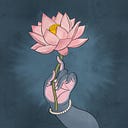Hanumān fetching the Mrutasanjīvani:
The Vālmīkī Rāmāyaṇa in Cambodian art
Cambodia, Koh Ker style, 10th century bronze
तयोः शिखरयोर्मध्ये प्रदीप्तमतुलप्रभम्
सर्वौषधियुतं वीर द्रक्ष्यस्यौषधिपर्वतम् ६-७४-३१
“O valiant Hanuma! In the midst of these two peaks (Mount Kailasa and Rishabha), you will see a blazing and unequally brilliant herbal mountain, containing all kinds of herbs.”
मृतसञ्जीवनीं चैव विशल्यकरणीम् अपि
सौवर्णकरणीं चैव सन्धानीं च महौषधीम् ६-७४-३३
“You can see there, Mrita Sanjīvani (capable of restoring the dead to life), Vishalyakarani (capable of extracting weapons and healing all wounds inflicted by weapons), Suvarnakarani (restoring the body to its original complexion) and Sandhani, the great herb (capable of joining severed limbs or fractured bone).”
Yuddha Kanda 6.74.31–33
The Rāmāyaṇa had gained popularity in Cambodia by the 600s. In a dramatic scene from the epic, Hanuman, who is able to fly, raises his left hand in a gesture meaning “Fear not!” In his raised right hand he carries an antidote to a poison that has rendered Rāma and Lakshmana unconscious. The garment’s wide parallel pleat lines, the swinging flared swath between his legs, the tiered conical crown, and the broad volumes of the chest are stylistic hallmarks of Khmer art of the tenth century.
Hanumān, holding aloft the mountain of herbs (Sanjīvani), which he is carrying from the Himalayas to heal wounded Rāma and Lakshmana.
स भास्कराध्वानमनुप्रपन्नस्
तद्भास्कराभं शिखरं प्रगृह्य
बभौ तदा भास्करसंनिकाशो
रवेः समीपे प्रतिभास्कराभः ६-७४-६९
Holding that mountain-peak, that radiant Hanumā who resembled the sun, having reached the orbit of the sun, shone as a second sun (or as the sun’s image) in the vicinity of the sun.
स तेन शैलेन भृशं रराज
शैलोपमो गन्धवहात्मजस्तु
सहस्रधारेण सपावकेन
चक्रेण खे विष्णुरिवार्पितेन ६-७४-७०
“In the sky, with that mountain in his hand, Hanumā, the son of the wind-god, who resembled a mountain himself, appeared exceedingly like Śri Vishnu holding his flaming discus (Sudarśana chakra) with its thousand edges in his hand.”
Yuddha Kānda, Vālmīkī Rāmāyaṇa
______________________________________________________________
If you find value in my work, I hope you consider becoming a patron through Patreon. Hindu Aesthetic requires a lot of time and effort and your support would mean that I can continue bringing you the highest quality content. Link to my Patreon:
